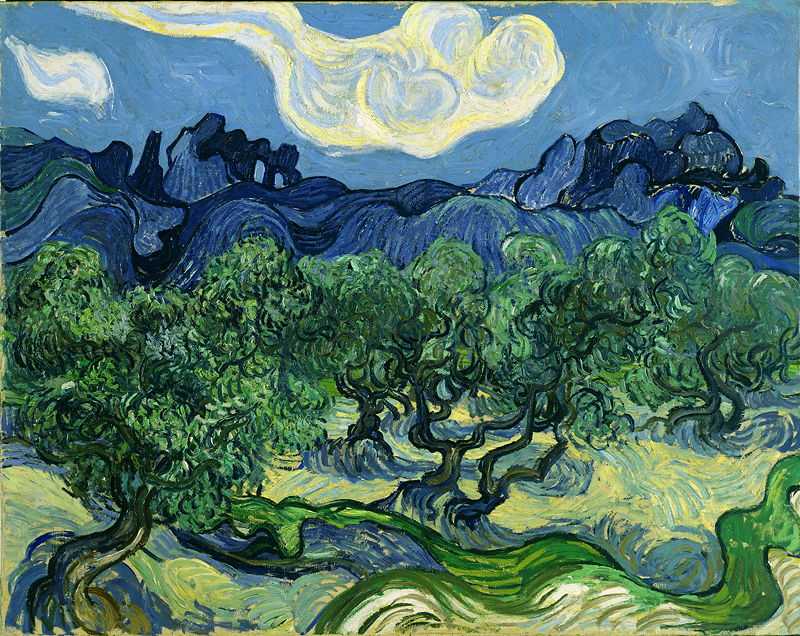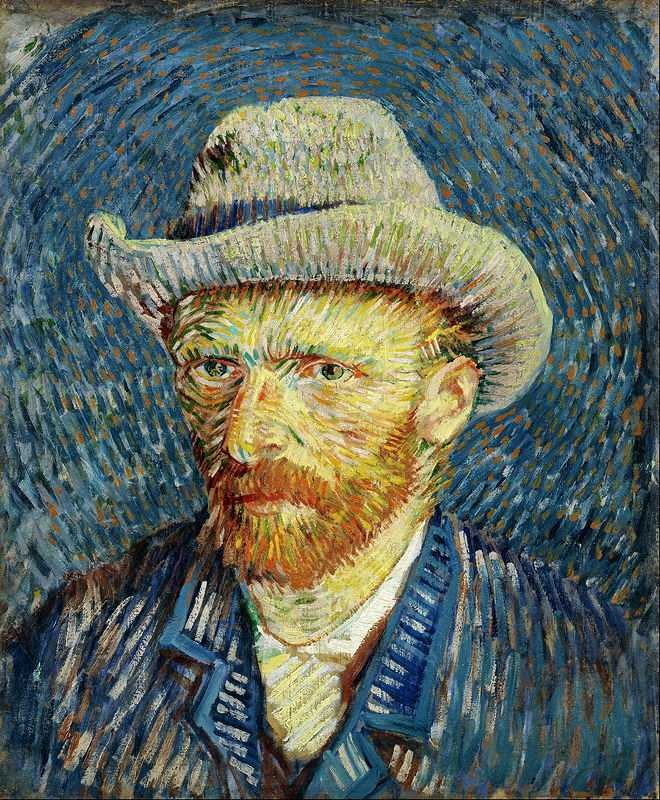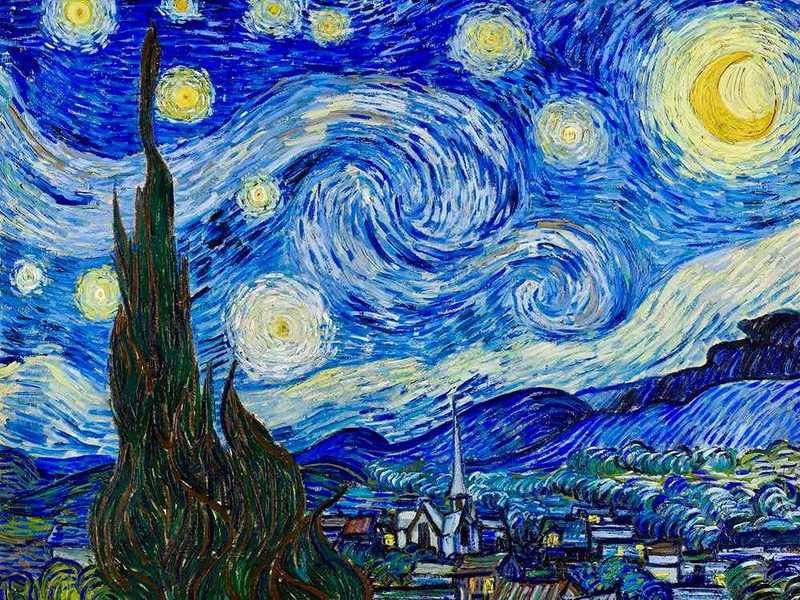1. Van Gogh - A Brief Bio
Van Gogh did not show any interest in becoming an artist until his twenties.
Born in the Netherlands in 1853, he first began drawing seriously in 1880. Prior to becoming an artist, he had worked (largely unsuccessfully) as an art dealer, a teacher, a preacher and a missionary.

Van Gogh's artistic career lasted just 10 years, from 1880 until his suicide in 1890.
For the first four years, van Gogh focussed on drawing and watercolours, studying drawing at the Brussels Academy. In 1882, Van Gogh began experimenting with oil paints and, the following year, he travelled to the north of the Netherlands in search of natural subjects.
The young artist was particularly interested in nature and the life of the peasants in the countryside. During this early period, after studying landscape painting with the Dutch artist Anton Mauve, Van Gogh's work gradually became bolder and more dynamic.
The influence of Japanese prints
He came across the work of the Impressionists whilst in Antwerp and his fascination with the art style began to grow. At the same time, Van Gogh was also exposed to Japanese prints. This was a dominant cultural influence on avant-garde art at the time.
After a brief time studying at the Antwerp Academy, where he quarrelled with tutors over the conventions of academic painting, Van Gogh decided to join his brother in Paris.
In 1886, he moved in with his brother, Theo Van Gogh, who was an art dealer. Theo introduced him to several influential impressionist painters including Camille Pissarro and Edgar Degas.
Meeting other artists
In Paris, Van Gogh also met young artists Paul Gauguin and Georges Seurat. Under these new artistic influences, Van Gogh’s style changed significantly.
His interest in the impressionist style is indicated by a letter written to Horace Mann Livens in 1886, where he says:
“In Antwerp I did not even know what the Impressionists were, now I have seen them and though not being one of the club, yet I have much admired certain Impressionist pictures – Degas, nude figure – Claude Monet, landscape."
As he grew closer to many of the Impressionist artists, he began working with Impressionist techniques in his artworks, focussing especially on self-portraits. During this period, Van Gogh began to use colours to express his emotions, beginning a trend that would come to define his later style.
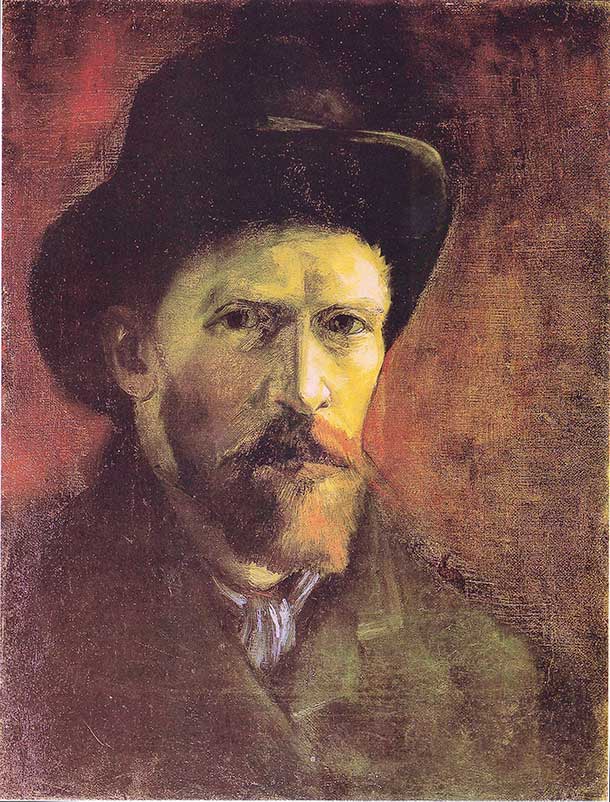
Moving to Provence and the deterioration of this mental health
In 1888, Van Gogh decided to move from Paris to Arles in Provence, entering into his most productive artistic period.
Joined by Paul Gauguin, the two artists lived together in the Yellow House (which van Gogh later painted) and collaborated on many works, drawing inspiration from one another.
It was during this period that Van Gogh painted some of his most famous works including his Sunflowers series and ‘Café Terrace at Night’.
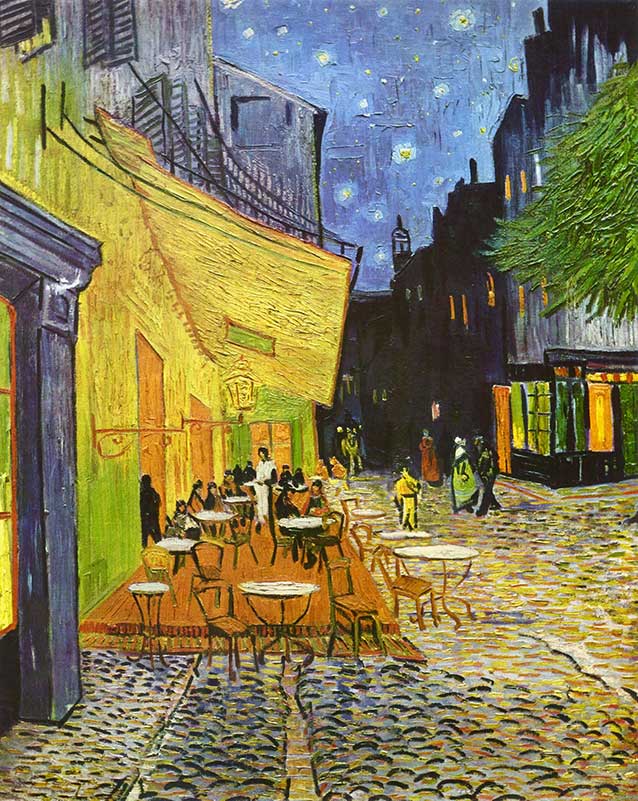
However, very quickly Van Gogh’s mental health deteriorated. He suffered from bouts of depression and was admitted to hospital.
Van Gogh's left ear
Most infamously, van Gogh severed his left ear and delivered the bloody flesh to a brothel worker in December 1888. The incident was sparked by van Gogh's paranoia that Gauguin was going to leave the two-man artistic colony they had created in Arles.
The incident also has elements of tragic comedy: van Gogh returned home after making his unusual delivery and passed out due to blood loss. The next morning, when the blundering local police started to investigate, they thought that van Gogh was dead and arrested Gauguin for his murder.
Recovery and then suicide
During his recovery, Van Gogh painted many works from images in his memory. These paintings are more lyrical than his earlier paintings, featuring movement and swirling, dreamlike brushstrokes.
Sadly, Van Gogh was unable to tackle the feelings of disillusionment, guilt and frustration that overwhelmed him. He eventually shot himself on 27th July 1890, saying to police
“What I have done is nobody else’s business. I am free to do what I like with my own body.”
He died two days later.
Vincent's fame came after his death. Critics and fans transformed his life into a story of tragedy and drama, taking van Gogh as the ideal image of a struggling, tortured artist. He is now a legendary figure, closely tied to the impressionist movement but also belonging to his own category of artistic genius whose work continues to fascinate art lovers around the world.
Learn more about Vincent's life on our van Gogh biography page.
2. Yes, van Gogh was an Impressionist
Like the impressionists, Van Gogh sought to break free from the conventions of academic painting that he had been taught at the start of his career.
The Impressionist movement offered him an alternative to the rigid expectations of European painting at the time and gave him an outlet to begin experimenting with his own style.
Moving to Paris
Moving to Paris, van Gogh ingratiated himself with the Impressionist group through his brother, Theo.
He socialised with many artists of the Impressionist movement on the Boulevard de Clichy, visiting cafés such as le Café du Tambourin and the Moulin de la Galette in Montmartre.
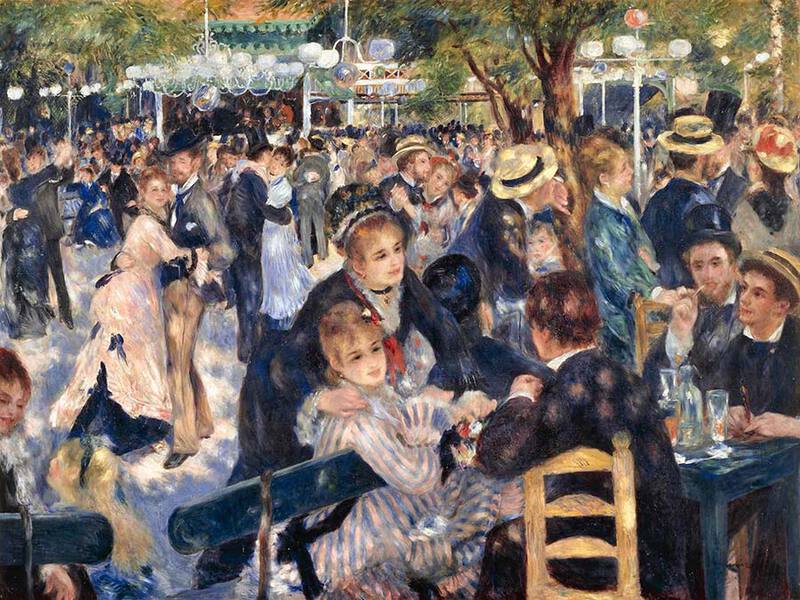
In this setting, van Gogh was exposed to new ideas surrounding art and artistic expression and the tutelage of prominent Impressionist artists, especially Pissarro.
Whilst in Paris, van Gogh’s painting style changed significantly. In his early career, he was heavily influenced by Peter Paul Rubens and he had travelled to Antwerp in search of a collection of Ruben’s works.
But when van Gogh encountered the impressionists, he began incorporating the impressionist technique of short, quick brushstrokes into his painting. Furthermore, he transformed his colour palette from the browns and blacks of the Dutch style towards vibrant, bold colours and lighter tones.
1. The influence of Impressionism in Van Gogh's paintings
With the impressionists, van Gogh was able to experiment and push the boundaries of art beyond what was accepted and expected at this time. Van Gogh’s Montmartre series from 1887 is an ideal example of impressionism’s influence on his painting.
In this series, van Gogh focussed on the countryside around Montmartre, painting in soft, naturalistic colours and using short, dabbed brushstrokes. He paid attention to natural light in particular, painting fields, farm buildings and the sky in gentle tones.
‘View of Paris from Montmartre’ from 1886-87 also shows Van Gogh’s interest in the Impressionist goal of painting everyday life in an honest light.
Hence, this painting shows smoke-filled Paris as an industrial city, complete with chimneys and grey rooftops. The sky in the image is bleak, painted with thick, impasto paint that is typical of the Impressionist style.
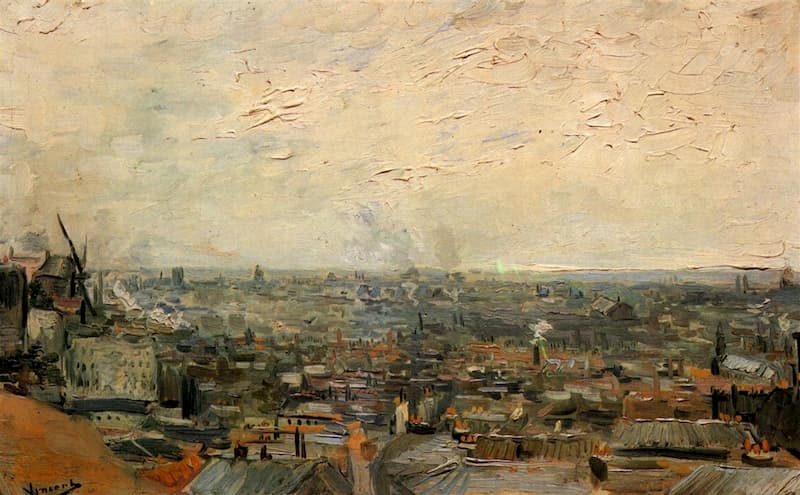
From the summer of 1887 onwards, Van Gogh’s painting became brighter and more colourful. His brushstrokes also became far shorter, bordering on pointillism. He worked quickly, seeking to capture an instant in time.
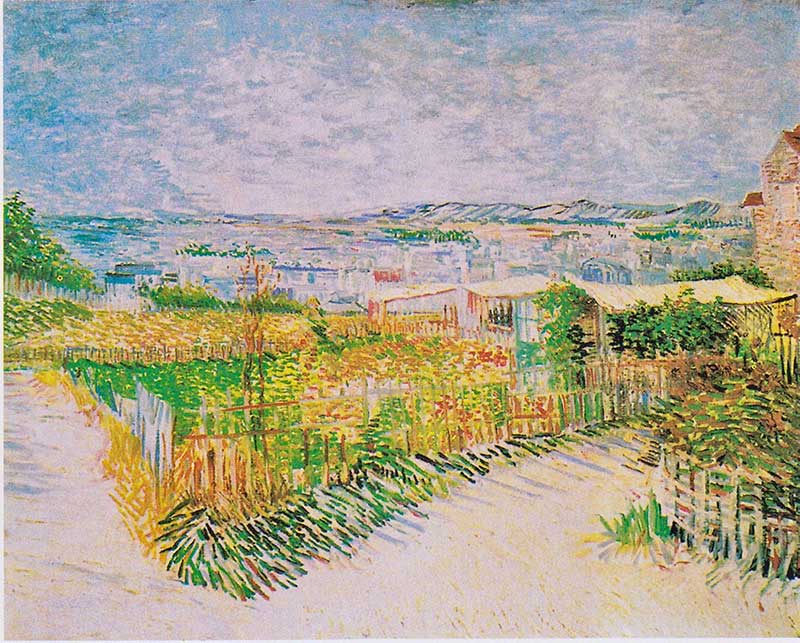
Often these instantaneous moments captured the scene but also his feelings at that moment. Drawing on the impressionist style, Van Gogh also used complimentary colours and optical mixing to build up the images.
2. Painting Everyday Life
Before he made the journey to Paris, Van Gogh was focussing heavily on depictions of the peasants in rural Holland.
His work was closely linked to images of the daily life of peasants, including the hardships they faced. He also sought to capture the landscape in which the peasants worked and lived.
Paintings such as ‘The Potato Eaters’ from 1885 show Van Gogh’s desire to paint people in raw, unassuming settings. This links his work to that of the Impressionist movement and artists including Edgar Degas and Edouard Manet.
However, the stylistic features of these early works are distinctly his own, lacking the feathered brushstrokes and pastel palette of the Impressionist style.
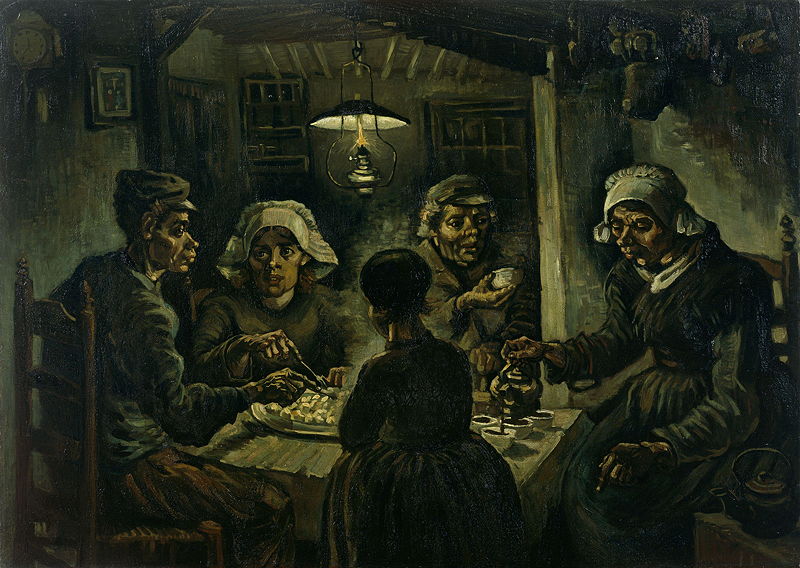
3. Painting still lifes
In this way, Van Gogh’s work centred on similar subjects to the impressionists. When in France, he also painted many still-life works.
‘Bouquet of Flowers in a Vase’ from 1889-90 is one such work, echoing the still life paintings of Monet in particular.
There are clear parallels between Monet’s Impressionist paintings of Chrysanthemums from between 1878 and 1883 and many of Van Gogh’s still life paintings, especially the bright colours and thick, short brushstrokes that make up the petals of the flowers.

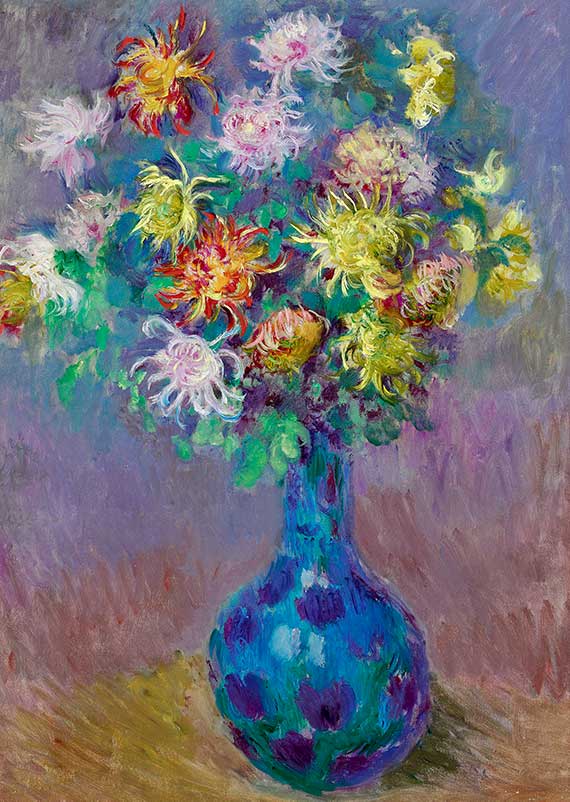
Much like the Impressionists, Van Gogh also took inspiration from the world around him. When he moved to Arles in 1888, he incorporated the bright light of the southern sun into his paintings.
This is evident in paintings like ‘The Langlois Bridge at Arles with lady and umbrella’ from 1888, which shines with the natural bright sunlight of Provence. His desire to paint en plein air demonstrates the close relationship he had with Impressionism, especially in his landscape paintings.
3. No, Van Gogh was not an Impressionist
There is no doubt that van Gogh borrowed from the impressionist style in his art but it is doubtful that he was fully impressionistic.
The key difference is his use of unnatural and abstract colour in his work, which drew on colour contrasts rather than the effects of natural light.
This meant that van Gogh did not adhere to the impressionist principle of representing subjects as they appear:
- The Impressionists sought to use colour in a natural way, to capture the world they saw around them.
- Van Gogh, on the other hand, chose to manipulate colour as a symbolic element in many of his paintings, using dramatic colour contrasts to create a sense of atmosphere rather than reality.
The full effect of colour
Van Gogh developed a fascination in the “full effect of colour” later into his career, squeezing paint directly onto his canvas from the paint tube and creating dizzying works of saturated colour contrasts.
This can be seen in van Gogh's most famous work, The Starry Night (1889).

These paintings are far removed from the soft tones of the Impressionist style and represent something that was van Gogh’s own.
Van Gogh himself recognised that his interests were not entirely compatible with the original artists of the Impressionist movement. Instead, he wished to establish a separate Impressionist group consisting of himself, Gauguin and Henri Toulouse-Lautrec.
Van Gogh's stay in Arles
Van Gogh hoped to continue using the impressionist technique but also to experiment with other methods.
He chose Arles as the location for his new artistic community, away from the pressures of city life in Paris. This geographic separation from the centre of the Impressionist became highly significant. Though the other artists did not follow him, Van Gogh’s move to Arles signalled the start of a highly experimental period.
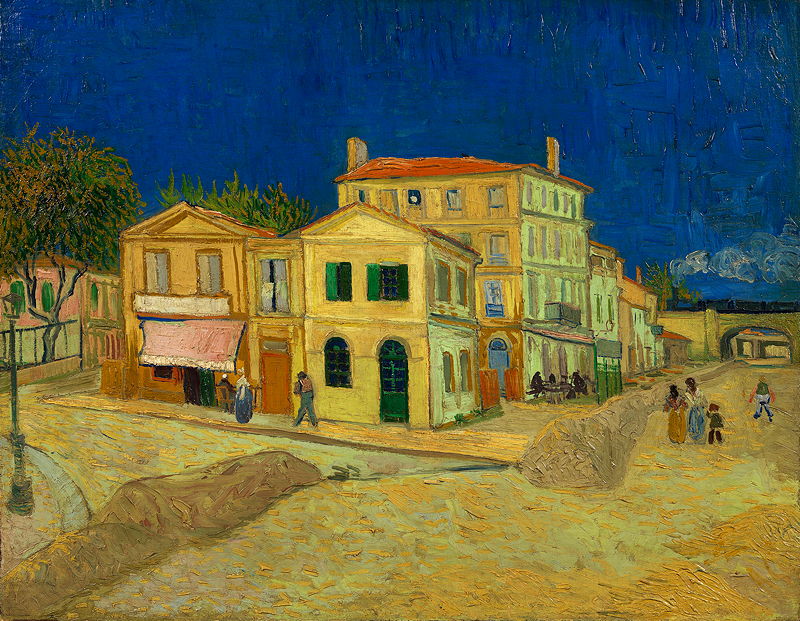
Whilst in Arles from February 1888, Van Gogh continued to paint natural subjects and ordinary life but he did so in a bold, almost psychedelic manner.
His paintings sought to capture not just the visual features of the landscape but also to paint his internal feelings onto the canvas. He used the time in the south of France to further his own, distinct style of painting.
The Bedroom
As well as impressionist paintings, Van Gogh was also exposed to Japanese prints, an art style that had a significant influence on the Impressionist technique.
In his later paintings from Arles, the Japanese influence is evident. ‘The Bedroom’ from 1889 is one such example, featuring the flat composition and distinct outlines of the Japanese style.
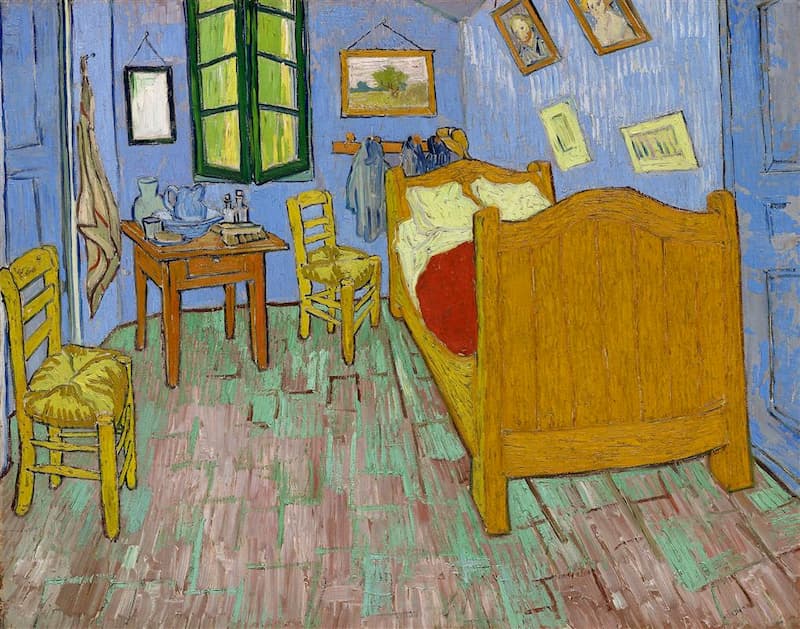
By 1888, van Gogh’s style had become fully post-impressionist. Paintings such as ‘Portrait of Père Tanguy’ from and ‘Self-Portrait in Front of Easel’ are some of the best examples of his unique style.

Self-Portrait with a Bandaged Ear
Similarly, ‘Self-Portrait with Bandaged Ear’ can be seen as an indication of van Gogh’s firmly post-impressionist style.
‘Self-Portrait with a Bandaged Ear and Pipe’ epitomises Van Gogh’s later work. Rather than the Pointillist inspired brushstrokes of his Parisian paintings, this work uses longer brushstrokes, laid in similar directions to form parts of the composition.
These brushstrokes are very distinctive and typical of Van Gogh’s later style.
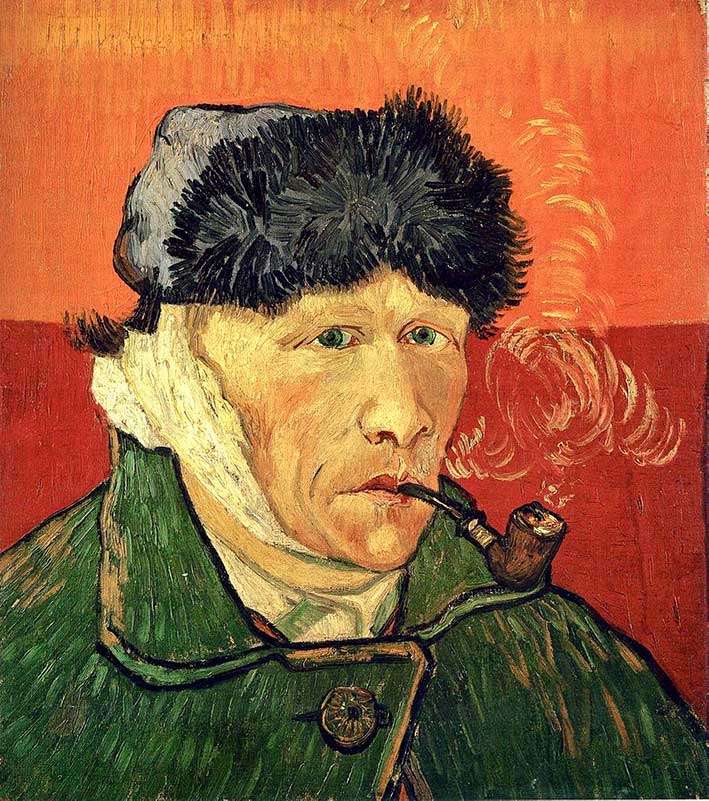
Furthermore, this painting also features the contrasting colours of Van Gogh’s personal brand of post-impressionism. He wears a green coat, set against a red and orange background.
The colours are dazzling, far removed from the softer tones of Impressionist artists like Claude Monet and Berthe Morisot.
A unique use of contrasting colours
As well as contrasting colours, Van Gogh also frequently used black in his painting. This is something that many impressionists sought to move away from. Manet and Morisot continued to use black but to a much lesser extent than many other artists.
Pure black was a feature that was generally avoided by the impressionists and yet many of Van Gogh’s works feature this pigment.
He used colour to represent an intense visual world, creating a truly individual style. This often involved black for outlines and shadows. Van Gogh’s post-impressionist style is best seen in artworks such as ‘Wheatfield with Crows’ from 1890, which has now become known as one of the most impressive works of his entire career.
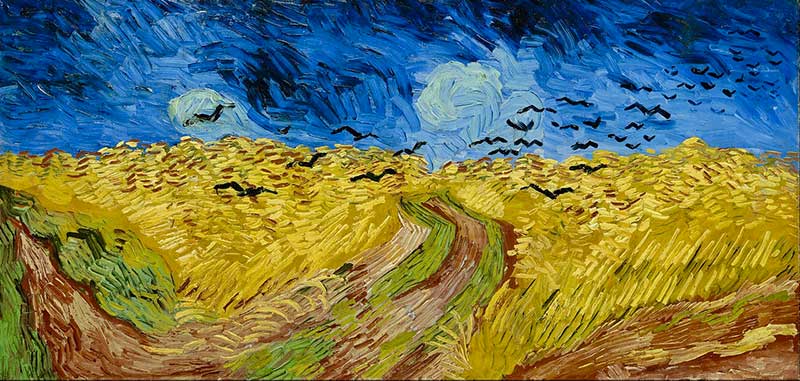
4. Van Gogh and the Impressionist movement
There is no doubt that the impressionist movement had an enormous impact on van Gogh’s artistic development.
Through the impressionists, he learnt how to paint in a less traditional style, experimenting with novel colour effects and visible brushstrokes and moving away from academic painting.
When considering his oeuvre as a whole, there are many aspects of the impressionist movement that shine through in Van Gogh’s work.
(1) Productivity
He was a prolific artist, painting over 800 oil paintings and producing around 700 drawings during his short artistic life. In these works, there are numerous examples of the Impressionist style. It is perhaps for this reason that Van Gogh is often classed as Impressionist in popular culture.
(2) Breaking away from conventions
As well as the stylistic innovations of the impressionist movement, van Gogh also followed many of the conventions of Impressionist painting in his choice of subjects.
The Impressionist movement focussed heavily on painting landscapes en plein air and depicting ordinary life. By following their lead, van Gogh was free to experiment with painting the world around him, seeking to capture everyday subjects in a rapidly modernising world.
However, it is also possible to map the transformation from impressionism to post-impressionism in Van Gogh’s later paintings.
He abandoned the natural, soft colour palettes of the impressionist movement and instead began using stark, brilliant colours that were far more expressionist. In the later period of his career, Van Gogh’s works take on a style that is entirely their own.
(3) Beyond Impressionism
In this way, Van Gogh moved beyond the conventions of impressionism. His later and most famous work cannot be said to be fully impressionist, lacking many of the naturalistic features of the impressionist style.
Despite borrowing from key principles of the impressionist style, his intense paintings are too distinctive to belong to the impressionist movement. As a result, van Gogh is regarded principally as a post-impressionist painter.
5. Discover More
Discover more about van Gogh and the impressionists on this site.
We suggest:
- Our Top 10 Paintings Page, which has a bonus entry devoted to van Gogh.
- Our pages on the other post-impressionists, such as Paul Gauguin (who, as we explain above, shared the Yellow House with van Gogh).
- Our quiz page.
Van Gogh resources
To take your knowledge to the next level, check out our resources page - you'll find recommendations for the best impressionist books, videos and gifts.

